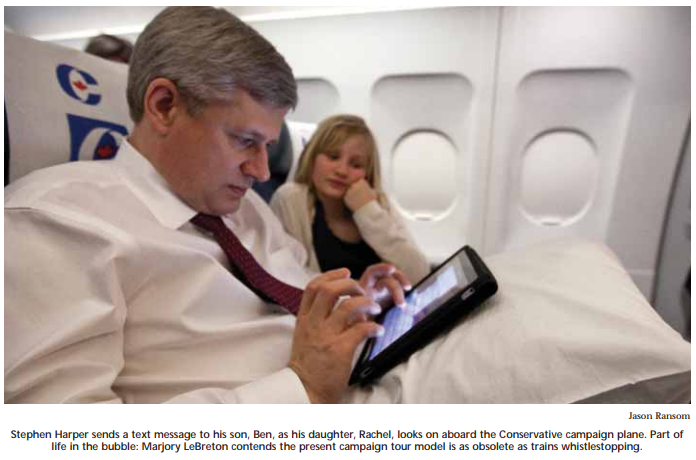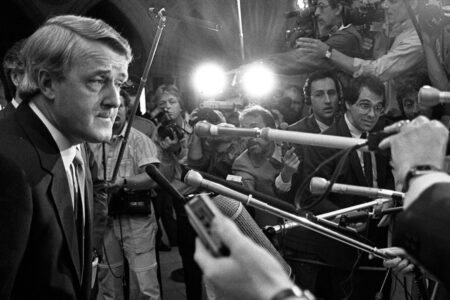
On Friday, March 25, the opposition Liberals, NDP and Bloc Québécois joined forces in a coalition and defeated Prime Minister Stephen Harper’s minority Conservative government on a little-understood partisan motion that the government was in contempt of Parliament. Most Canadians clearly understood the perils of governing in a minority situation, where opposition MPs controlled parliamentary committees, turning them into inquisition chambers instead of proper parliamentary oversight vehicles; where the House of Commons Question Period became a daily “gong show” of accusatory and vexatious charges. Canadians also understood that Prime Minister Harper had served as a minority PM for over five years — an all-time Canadian record — and thus did not believe that our democracy was in peril.
People also understood that the budget delivered on March 22 was a solid, sensible blueprint for the next phase of Canada’s highly successful Economic Action Plan and that it was well received across the board — by labour, business (small and large) and, most importantly, individual Canadian taxpayers. Indeed, the budget was as stated — “A Low-Tax Plan for Jobs and Growth.” Most understood full well that the opposition coalition defeated the government on a ruse — but in reality, Canadians were not fooled. They believed the government was defeated to prevent the passage of a popular budget.
And so it was that for the third time in just over five years, I departed Ottawa on March 26 as a member of the Conservative national campaign tour. The following is a personal reflection on what will be described for years to come as one of the most interesting elections this country has ever seen and on how the Ottawa-based mainstream media, aided and abetted by pollsters and pundits, on whom they rely so heavily, completely missed the real story of Election 2011. From the outset of the campaign, the media accused the Prime Minister of campaigning in a bubble. Indeed, there was a “bubble,” but it was the national mainstream media (MSM) who occupied this isolated place and who, for various reasons, seemed unable to break away from it.
I had the privilege of travelling with John Diefenbaker during the fall of 1965 — he was leader of the opposition at the time, and Prime Minister Pearson called the election for the sole purpose of trying to form a majority government (he didn’t). The 1965 Diefenbaker national tour travelled the country almost exclusively by train — the last time in Canada that the train was used for this purpose. I mention this only to suggest that I may have travelled on the last national campaign tour to use designated charter aircraft to transport the leader, the accompanying staff and media to the various regions of the country. This has been the method of national campaign touring since the 1968 election. It may be time to do a serious rethink as to whether this is the best modus operandi going forward.
Clearly it is important and necessary for our leaders to extensively travel the country, meet and communicate with Canadians and debate the important issues that should be addressed in a national election campaign. Of no small consequence in this debate is the enormous cost, not only to the party’s national campaign, but also to the various news bureaus who purchase a seat or seats for their journalists. From the point of view of the national campaign, the question is whether this money would be put to better use if the leader’s tour was organized to allow for a more efficient use of time; to expand outreach programs; to increase the use of advertising; to use new age communications tools to disseminate policy and candidate information; and finally to further support regional campaigns by strengthening electoral district associations.
From the point of view of the national media, one could argue that the news reports emanating from Campaign 2011 could not possibly justify the huge expense borne by the various news organizations. I would argue that the public did not benefit from the distorted reports specifically covering the Conservative leader’s national tour. In fact, just the opposite — when one compares the reporting and predictions of most of my travelling companions with the results that rolled in on May 2, the facts are clear: a total disconnect between the prevailing or collective view of the MSM “in the bubble” and the reality on the ground was evident for all to see.
On a personal level, I like and respect most members of the national media and enjoy their company. I fully understand that they have a job to do — just as they understand our role on the political side. But much has changed, even in the past five years. In fairness to my journalist friends, I did observe the enormous pressure they are under to satisfy all the demands of the new media — often acting alone with little or no support. What with Twitter, YouTube, blogs, Skype and, of course, their normal responsibilities of preparing and filing stories for their news organizations, there is precious little time to actually participate in some good old-fashioned spadework. As a consequence, a good portion of their time was spent talking to or tweeting each other and regurgitating what this pollster or that pundit said with no sense that any of this was connected to reality, hence resulting in self-fulfilling prophesies.
The new media also create problems for political people who are working with the media. Yes, providing context and background are still useful activities, but gone are the days when there was an opportunity to correct the record or clear up a misunderstanding — the “gotcha” mentality prevails and once something is reported on Facebook or Twitter there is no going back. Accuracy or fairness does not enter the realm of possibility and this creates an atmosphere of extreme caution and suspicion. This is a one-way street and most people on the political side take the view “once burned, twice shy.” The new instant reporting phenomenon — Twitter — has erected an impenetrable wall that completely removes any sense of trust, let alone camaraderie, between the media and politicos.
I would argue that the public did not benefit from the distorted reports specifically covering the Conservative leader’s national tour. In fact, just the opposite — when one compares the reporting and predictions of most of my travelling companions with the results that rolled in on May 2, the facts are clear: a total disconnect between the prevailing or collective view of the MSM “in the bubble” and the reality on the ground was evident for all to see.
During the first week of Prime Minister Harper’s national tour, I clearly felt that it really did not matter what the Prime Minister said or did: the narrative had already been written and there was a predetermination to report a very successful week for Liberal Leader Michael Ignatieff — to level the playing field, so to speak. The reporting bears this out: we ran an error-free, efficient tour; the Prime Minister made a daily announcement, took questions from the media, did one-on-one interviews, (84 in total over the campaign), attended many events where he met Canadians where they work and live and ended each day with a successful rally attended by our supporters. I got a taste of what was to come at the “media avail” on the second day — Sunday, March 27, which turned into a bit of a media mob scene. The Prime Minister’s answer did not square with the CBC’s interpretation of a 2004 letter sent to the Governor General. The CBC’s Terry Milewski did not like the answer and this was the beginning of several outbursts and interruptions by this reporter directed at the Prime Minister — “You didn’t answer the question.” The truth is, the Prime Minister did answer the question (always politely) — it was the answer the reporter did not like!
The media complained incessantly about the decision to take only five questions at the end of each campaign announcement. Five questions should have produced plenty of useful material for their stories. I frankly was more than a little surprised at the quality of questions (more trivia than substance) pursued by the “national” media. Did they use the five questions to ask about our policies, the policies of the NDP or of the Liberals or other stories that may be of interest to the public at large? The answer is a clear no — rather, the Prime Minister was asked questions about compelling national issues such as a former controversial ministerial staffer who was volunteering by putting up lawn signs in an Edmonton riding; another on a volunteer working in a local Quebec riding campaign; several about the legal and personal travails of a former staff member in the PMO; whether the Prime Minister was going to launch an investigation into the defaced campaign signs of one of our opponents; and the question of all questions — “Why don’t you take more questions?
Such was the first week of the campaign. The collective view communicated by media travelling with us was that the Harper campaign was subdued and unenthusiastic — something was amiss. (I personally tried to make light of these views by saying what I believed: most of us were still in a state of shock that we were actually into an election campaign — so convinced was I like others, that the NDP would declare a win and support the budget.) In any event, as predicted, the summary of the first week was very negative about our Conservative campaign and favourable to the Liberal leader, with a national magazine cover stating “Round One — Ignatieff.” I thought to myself — this is going to be a long campaign!
I won’t belabour the tone and quality of the questions directed toward the Prime Minister during weeks two through five of the campaign. Suffice to say that the pattern of the first week continued throughout. The Prime Minister held 32 media avails (potential for at least 160 substantive questions) during the campaign — a quick review indicates that 65 percent were could be categorized in the trivia/minutiae category and 35 percent on substantive issues relevant to the choice facing Canadian voters.
There was a startling difference between the process-oriented questions by the MSM and the content, policy-oriented questions that the Prime Minister answered during all of his 84 one-on-one interviews with local, regional and multicultural media.
The question is, Where do we go from here? Times change, and this is particularly true when one looks at how much has changed for politicians and the media covering them. It may be that our present style of campaigning has fallen victim to the Internet age, where we have been overtaken by tweeting, blogging and Facebooking, with journalists under enormous pressure to churn out “news” regardless of the veracity of the content — all of this at a tremendous cost to a still very legitimate source of information for Canadian citizens: newspapers, radio and television, where it is still possible to capture the essence of any given campaign. I use the word “victim” advisedly because this is a new reality and there is no going back. The point is this new phenomenon probably means that the present mode of campaigning is no longer relevant. Has this new age media changed forever the need to have national reporters pile onto a designated aircraft to cover our political leaders? It seems to me that this long-standing practice of shadowing our leaders, preparing and filing traditional stories that actually cover the election, is passé. Just as the Diefenbaker train was in 1965.
I would argue that this new age is precisely why our MSM media completely missed what was actually happening on the ground in Election 2011, and as I stated before, this is not entirely their fault. This new age has changed the face of political reporting: journalists now feel emboldened not only to report the news but to create it, tweeting minute-by-minute showdowns, often with their personal bias thrown in for good measure. When the views of pollsters and pundits were inserted into the mix, the travelling media absorbed the information like a sponge — for some, it was the only information available to them, and for others, it fit the narrative of what they chose or wanted to believe. One such occasion was on Thursday, April 28, travelling on the media bus from Quebec City to Montreal. An Ekos/Frank Graves poll hit and caused quite a stir. It showed declining support for the Conservatives and a surge for the NDP, and it put the Liberals in a poor third place. Graves’ seat projections indicated a much-diminished minority for Harper’s Conservatives. There was some suggestion that the two parties could end up tied. I found it somewhat odd and was quite surprised that my media friends seemed to put more stock in Graves’ polls than the others (even their own), which confirmed my suspicions that this is what some of them wanted to believe. I have long been a skeptic when it comes to Graves — and pretty well discounted any of his work, especially after his advice to the Liberals to engage in a “cultural” war against Conservatives. Nevertheless, the talk on the media bus can only be described as excited anticipation: Who would have what post in an NDP government? How long would Stephen Harper survive as leader of the Conservative Party? How many days before Michael Ignatieff would be pushed out? There was talk of who would lead the Liberal Party — was Justin Trudeau ready?
Listening to all of this, I found myself wondering what planet I was living on. I regularly consulted with my campaign colleagues at Conservative headquarters and on the tour and also relied on a network of friends, colleagues and other acquaintances across the country. After each campaign event across the country, I spent a considerable amount of time talking to Conservative candidates and campaign workers who consistently reported that they were getting a much better response at the doors, at all-candidates meetings and in the public than they did in 2006 or 2008. As well, I constantly studied the results in close ridings in Election 2008 to determine the prospects of holding onto existing seats and winning the ones we narrowly lost. On top of all of that — a fact completely overlooked by my media friends and which I reminded them of constantly — we were still leading in every published public opinion poll, albeit with very different margins.
What was happening in Ontario, particularly in the GTA in the suburban 905 region and indeed in Toronto (416), was given little attention by the touring media, even though there was plenty of evidence that something was happening. Goodness only knows — I tried to point this out. There was ample evidence that the voters of Ontario were indicating strong support for Prime Minister Harper and our government’s Economic Action Plan. Add to this the memory of a chaotic NDP government and the consequences for Ontario’s economy. Regional polls actually picked up the growing support in Ontario but this evidence was overlooked and in some cases dismissed — so consumed was everyone with the overriding national numbers. May 2 produced a majority Conservative government with a strong showing by the NDP as official opposition. I expect a healthy bit of revisionist history here, but the truth is that few in the MSM predicted this result (most predicted a diminished Conservative minority and a few an NDP minority).
I conclude with the point I have made throughout: the time has come to seriously rethink how future national campaigns are organized — realities of new age communications demand this, and if the past five years are any indication, we can expect technologies to change again and again and yet again. Our leaders must still travel from coast to coast to coast to meet and discuss the issues with Canadians where they work and live. The question is can we use our resources more efficiently and has the time come to change a model that is 43 years old!
It is necessary that all aspects of the national media rethink their role as well. Technology can deliver a story/message from anywhere at any time — is there a more efficient and less costly way to report the news using all of the new age technologies? Campaign 2011 has certainly proven that being confined to the so-called “campaign bubble” no longer fits with the new reality. To the individual members of our national media, it is to be hoped that the election results bring about a period of retrospection. I would add that this should also apply to the polling industry and most particularly those who have become the face of the industry, who can’t claim to be any better than their media colleagues in predicting the outcome.
Photo: Shutterstock







